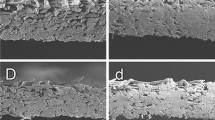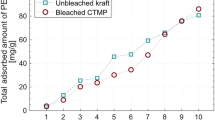Abstract
Pulp and paper fibers have favorable reinforcement properties, such as constant fiber quality, while being widely available at low cost. However, they also have severe drawbacks related to water uptake and material degradation. In this work, paper was used for sustainable reinforcement in thermoplastic composite laminates, which were characterized by thermal analysis and moisture uptake tests. The porosity of the composite samples with varying paper content and matrix material was determined by thermogravimetric analysis and related to their water uptake. Polypropylene and polyamide 12 matrix composites had the lowest porosities, between 2 and 6 vol%, and thus comparatively low water uptake. Additionally, the influence of moisture uptake on the mechanical properties of the composites was investigated by tensile testing, which resulted in a significant decrease in modulus and strength in the wet state. After drying, however, 70–90% of the original tensile properties were regained. Additionally, a nucleating effect of the paper surface could be observed, which led to a linear increase in matrix crystallinity with increasing paper content.






Similar content being viewed by others
References
Witik RA, Teuscher R, Michaud V et al (2013) Carbon fibre reinforced composite waste: an environmental assessment of recycling, energy recovery and landfilling. Compos Part A 49:89–99. https://doi.org/10.1016/j.compositesa.2013.02.009
Faruk O, Bledzki AK, Fink H-P et al (2014) Progress report on natural fiber reinforced composites. Macromol Mater Eng 299(1):9–26. https://doi.org/10.1002/mame.201300008
Lundquist L (2003) Novel pulp fibre reinforced thermoplastic composites. Compos Sci Technol 63(1):137–152. https://doi.org/10.1016/S0266-3538(02)00192-6
Malkapuram R, Kumar V, Negi YS (2009) Recent development in natural fiber reinforced polypropylene composites. J Reinf Plast Compos 28(10):1169–1189. https://doi.org/10.1177/0731684407087759
Sgriccia N, Hawley MC, Misra M (2008) Characterization of natural fiber surfaces and natural fiber composites. Compos Part A 39(10):1632–1637. https://doi.org/10.1016/j.compositesa.2008.07.007
Wambua P, Ivens J, Verpoest I (2003) Natural fibres: can they replace glass in fibre reinforced plastics?. Compos Sci Technol 63(9):1259–1264. https://doi.org/10.1016/S0266-3538(03)00096-4
Beg M, Pickering KL (2008) Accelerated weathering of unbleached and bleached Kraft wood fibre reinforced polypropylene composites. Polym Degrad Stab 93(10):1939–1946. https://doi.org/10.1016/j.polymdegradstab.2008.06.012
Beg M, Pickering KL (2008) Mechanical performance of Kraft fibre reinforced polypropylene composites: influence of fibre length, fibre beating and hygrothermal ageing. Compos Part A 39(11):1748–1755. https://doi.org/10.1016/j.compositesa.2008.08.003
Mohanty AK, Misra M, Hinrichsen G (2000) Biofibres, biodegradable polymers and biocomposites: an overview. Macromol Mater Eng 276–277(1):1–24. https://doi.org/10.1002/(SICI)1439-2054(20000301)276:1<1:AID-MAME1>3.0.CO;2-W
Azwa ZN, Yousif BF, Manalo AC et al (2013) A review on the degradability of polymeric composites based on natural fibres. Mater Des 47:424–442. https://doi.org/10.1016/j.matdes.2012.11.025
Bledzki AK, Jaszkiewicz A (2010) Mechanical performance of biocomposites based on PLA and PHBV reinforced with natural fibres—a comparative study to PP. Compos Sci Technol 70(12):1687–1696. https://doi.org/10.1016/j.compscitech.2010.06.005
Franco-Marquès E, Méndez JA, Pèlach MA et al (2011) Influence of coupling agents in the preparation of polypropylene composites reinforced with recycled fibers. Chem Eng J 166(3):1170–1178. https://doi.org/10.1016/j.cej.2010.12.031
Huda M, Drzal L, Mohanty A et al. (2006) Chopped glass and recycled newspaper as reinforcement fibers in injection molded poly(lactic acid) (PLA) composites: a comparative study. Compos Sci Technol 66(11–12):1813–1824. https://doi.org/10.1016/j.compscitech.2005.10.015
Vilaseca F, Méndez JA, López JP et al (2008) Recovered and recycled Kraft fibers as reinforcement of PP composites. Chem Eng J 138(1–3):586–595. https://doi.org/10.1016/j.cej.2007.07.066
Serrano A, Espinach FX, Tresserras J et al (2014) Study on the technical feasibility of replacing glass fibers by old newspaper recycled fibers as polypropylene reinforcement. J Clean Prod 65:489–496. https://doi.org/10.1016/j.jclepro.2013.10.003
Ren S, Hon DN-S (1993) Newspaper fiber-reinforced polypropylene composite. J Reinf Plast Compos 12(12):1311–1322. https://doi.org/10.1177/073168449301201205
Sanadi AR, Young RA, Clemons C et al (1994) Recycled newspaper fibers as reinforcing fillers in thermoplastics: part I-analysis of tensile and impact properties in polypropylene. J Reinf Plast Compos 13(1):54–67. https://doi.org/10.1177/073168449401300104
Du Y, Wu T, Yan N et al (2014) Fabrication and characterization of fully biodegradable natural fiber-reinforced poly(lactic acid) composites. Compos Part B 56:717–723. https://doi.org/10.1016/j.compositesb.2013.09.012
Graupner N, Ziegmann G, Wilde F et al (2016) Procedural influences on compression and injection moulded cellulose fibre-reinforced polylactide (PLA) composites: influence of fibre loading, fibre length, fibre orientation and voids. Compos Part A 81:158–171. https://doi.org/10.1016/j.compositesa.2015.10.040
Bourban Ch., Karamuk E, de Fondaumière MJ et al (1997) Processing and characterization of a new biodegradable composite made of a PHB/V matrix and regenerated cellulosic fibers. J Environ Polymer Degrad 5(3):159–166
Schwarz I, Stranz M, Bonnet M et al (2001) Changes of mechanical properties in cold-crystallized syndiotactic polypropylenne during aging. Colloid Polym Sci 279:506–512
Schubnell M Bestimmung der Kristallinität bei Polymeren aus DSC-Messungen. Metter Toledo UserCom 1/2001
Hofenauer A (2009) Funktionalisierung von Papieren durch Füllstoffe. Wochenbl Papierfabr 137(6–7):254–257
Prambauer M, Paulik C, Burgstaller C (2016) Evaluation of the interfacial properties of polypropylene composite laminates, reinforced with paper sheets. Compos Part A 88:59–66. https://doi.org/10.1016/j.compositesa.2016.05.016
Prambauer M, Paulik C, Burgstaller C (2016) Interlaminar interaction in paper thermoplastic laminate composites. IOP Conf Ser 139:12042. https://doi.org/10.1088/1757-899X/139/1/012042
Iyer KA, Lechanski J, Torkelson JM (2016) Green polypropylene/waste paper composites with superior modulus and crystallization behavior: Optimizing specific energy in solid-state shear pulverization for filler size reduction and dispersion. Compos Part A 83:47–55. https://doi.org/10.1016/j.compositesa.2015.09.011
Mathew AP, Oksman K, Sain M (2006) The effect of morphology and chemical characteristics of cellulose reinforcements on the crystallinity of polylactic acid. J Appl Polym Sci 101(1):300–310. https://doi.org/10.1002/app.23346
Assouline E, Pohl S, Fulchiron R et al (2000) The kinetics of α and β transcrystallization in fibre-reinforced polypropylene. Polymer 41(21):7843–7854. https://doi.org/10.1016/S0032-3861(00)00113-0
Prambauer M, Paulik C, Burgstaller C (2015) The influence of paper type on the properties of structural paper—polypropylene composites. Compos Part A 74:107–113. https://doi.org/10.1016/j.compositesa.2015.04.004
Biermann CJ (1996) Handbook of pulping and papermaking, 2nd ed. Academic Press, San Diego
Tejado A, van de Ven TG (2010) Why does paper get stronger as it dries?. Mater Today 13(9):42–49. https://doi.org/10.1016/S1369-7021(10)70164-4
Ianson S, Sampson W (2007) Competing Weibull and stress-transfer influences on the specific tensile strength of a bonded fibrous network. Compos Sci Technol 67(7–8):1650–1658. https://doi.org/10.1016/j.compscitech.2006.07.002
Hubbe MA (2006) Bonding between cellulosic fibers in the absence and presence of dry-strength agents—a review. BioResources 1(2):281–318
Magnusson MS, Zhang X, Östlund S (2013) Experimental evaluation of the interfibre joint strength of papermaking fibres in terms of manufacturing parameters and in two different loading directions. Exp Mech 53(9):1621–1634. https://doi.org/10.1007/s11340-013-9757-y
Acknowledgements
The authors are grateful to the Austrian Research Promotion Agency (FFG, Austria) for financial support of the project “Structural Paper-Thermoplastic Composites” in the scheme of “Industry-oriented Dissertation”.
Author information
Authors and Affiliations
Corresponding author
Rights and permissions
About this article
Cite this article
Prambauer, M., Paulik, C. & Burgstaller, C. Influence of Paper Content and Matrix Selection on the Porosity, Crystallinity and Water Uptake of Thermoplastic Paper Composites. J Polym Environ 26, 2007–2017 (2018). https://doi.org/10.1007/s10924-017-1098-y
Published:
Issue Date:
DOI: https://doi.org/10.1007/s10924-017-1098-y




